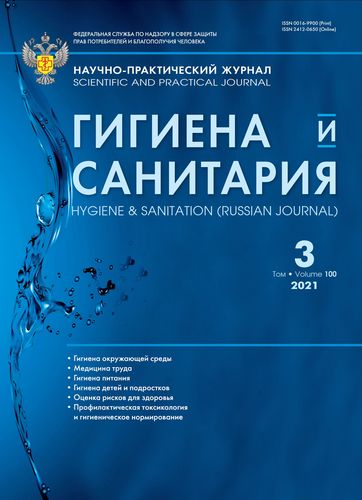Halotolerance of pseudomonads isolated from aquatic environment and fish (Sander lucioperca) in the Volga River delta
- Authors: Obukhova O.V.1, Lartseva L.V.2
-
Affiliations:
- Astrakhan State Technical University
- Astrakhan State University
- Issue: Vol 100, No 3 (2021)
- Pages: 204-207
- Section: ENVIRONMENTAL HYGIENE
- Published: 15.04.2021
- URL: https://rjraap.com/0016-9900/article/view/639390
- DOI: https://doi.org/10.47470/0016-9900-2021-100-3-204-207
- ID: 639390
Cite item
Full Text
Abstract
Introduction. The material shows halophiles bacteria R. Psendomonas the water’s microbiota and the pikeperch in spring and autumn. The attachment of Pseudomonas isolated from these habitats, certain Delta areas has not been identified.
Materials and methods. 190 “water” strains and 720 ones isolated from fish were experimentally tested. In meat-peptone broth (MPB) with 3.0, 7.0, and 10.0% NaCl content, daily cultures of analyzed bacteria were sown, incubation of which was carried out at 37 °C, and the results were taken into account after 24 and 48 hours.
Results. There were no significant differences in halophilicity in the analyzed strains, except for the autumn season, especially in 10.0% salt solution. Among the isolated pseudomonads, the maximum halotolerance in both biotopes was observed in P. fluorescens and P. alcaligenes in P. putida.
Halophiles strains of Pseudomonas that infect the water and fish had seasonal cycles. A slight decrease in the halophilicity of pseudomonades persistent in water and fish only at concentrations of 3.0 and 10.0 mg/l from spring to summer (1.1-1.2 times), and their significant rise in autumn (1.5 and 1.4 times) in the salt concentration of 3.0 mg/l. In the tested strains in spring and autumn, increased salt tolerance values were noted, which was determined by the hydrological and hydrochemical features of Delta waters and the “transfer” of bacteria in the body of walleye during its migration from the sea to the river.
Conclusion. Analysis of long-term material showed high halophiles studied strains of pseudomonad, indicating that their sanitary and epidemiologic danger, and the ability to remain viable in salted fish products
Keywords
About the authors
Olga V. Obukhova
Astrakhan State Technical University
Author for correspondence.
Email: obuhowa-ov@yandex.ru
ORCID iD: 0000-0002-2883-2963
MD, Ph.D., associate professor of the Department of Hydrobiology and general ecology of the Astrakhan State Technical University, Astrakhan, 414056, Russian Federation.
e-mail: obuhowa-ov@yandex.ru
Russian FederationLubov V. Lartseva
Astrakhan State University
Email: noemail@neicon.ru
ORCID iD: 0000-0003-3165-2143
Russian Federation
References
- Obukhova O.V., Lartseva L.V. Mikrobiotsenoz of Water and a Pike Perch (Sander lucioperca) in the Delta of the Volga River [Mikrobiotsenoz vody i sudaka (Sander lucioperca) v del’te r. Volgi]. St. Petersburg: Prospekt Nauki; 2015. (in Russian)
- Vaz-Moreira I., Nunes O.C., Manaia C.M. Diversity and antibiotic resistance in Pseudomonas spp. from drinking water. Sci. Total Environ. 2012; (426): 366–47. https://doi.org/10.1016/j.scitotenv.2012.03.046
- Smith P., Alday-Sanz V., Matysczak J., et al. Monitoring and surveillance of antimicrobial resistance in microorganisms associated with aquatic animals. Rev. Sci. Tech. 2013; 32(2): 583–94. https://doi.org/10.20506/rst.32.2.2237
- Werkman M., Murray A.G. et al. Seasonality in live fish movements and its effects on epidemic dynamics. Aquaculture. 2014: 418–9.
- Daraseliya G.Ya. Biological Safety of Food: Studies [Biologicheskaya bezopasnost’ produktov pitaniya]. Astrakhan’: AGTU; 2006. (in Russian)
- Liston J. Microbial hazards of seafood consumption. Food Technol. 1990; 44(12): 58–62.
- Pivovarov Yu.P., Korolik V.V. Sanitary and Significant Microorganisms [Sanitarno-znachimye mikroorganizmy]. Moscow: IKAR; 2000. (in Russian)
- Holt J.G. Bergey’s Manual of Determinative Bacteriology. Baltimore: Williams & Wilkins; 1994.
- Lartseva L.V., Proskurina V.V., V’yushkova L.A. Sanitary epizootic situation of the Volga-Caspian region at the turn of the XXI century. Rybnoe khozyaystvo. Bolezni ryb v akvakul’ture: obzornaya informatsiya. 2002; (1): 50. (in Russian)
- Lisitskaya I.A. Bacterial community of some components of the ecosystem of the delta of the Volga and Northern Caspian: Diss. Astrakhan’; 2008. (in Russia)
- Obukhova O.V., Lartseva L.V. Halotolerance of enterobacteria isolated from water and fish in the delta of the Volga River. Gigiena i Sanitaria (Hygiene and Sanitation, Russian journal). 2015; 94(5): 28–30. (in Russian)
- D’yakova S.A., Ruban E.A., Shokasheva D.I. Sanitary-microbiological research of water area of the licensed area «Central Caspian». In: Collection of Scientific Papers «Fisheries Research in the Caspian Sea in the Conditions of Development of Oil and Gas Fields» [Sbornik nauchnykh trudov «Rybokhozyaystvennye issledovaniya v Kaspiyskom more v usloviyakh osvoeniya neftegazovykh mestorozhdeniy»]. Astrakhan’; 2015: 58–62. (in Russian)
- Volodina V.V., D’yakova S.A. Conditionally pathogenic microflora of the Caspian seal (Phoca caspica) and its habitat under anthropogenic pressure. Trudy VNIRO. 2016; 162: 87–96. (in Russian)
- Katunin D.N. Hydro-Geological Basis for the Formation of Ecosystem Processes in the Caspian Sea and the Delta of the Volga River [Gidroekologicheskie osnovy formirovaniya ekosistemnykh protsessov v Kaspiyskom more i del’te reki Volgi]. Astrakhan’; 2014. (in Russian)
Supplementary files









